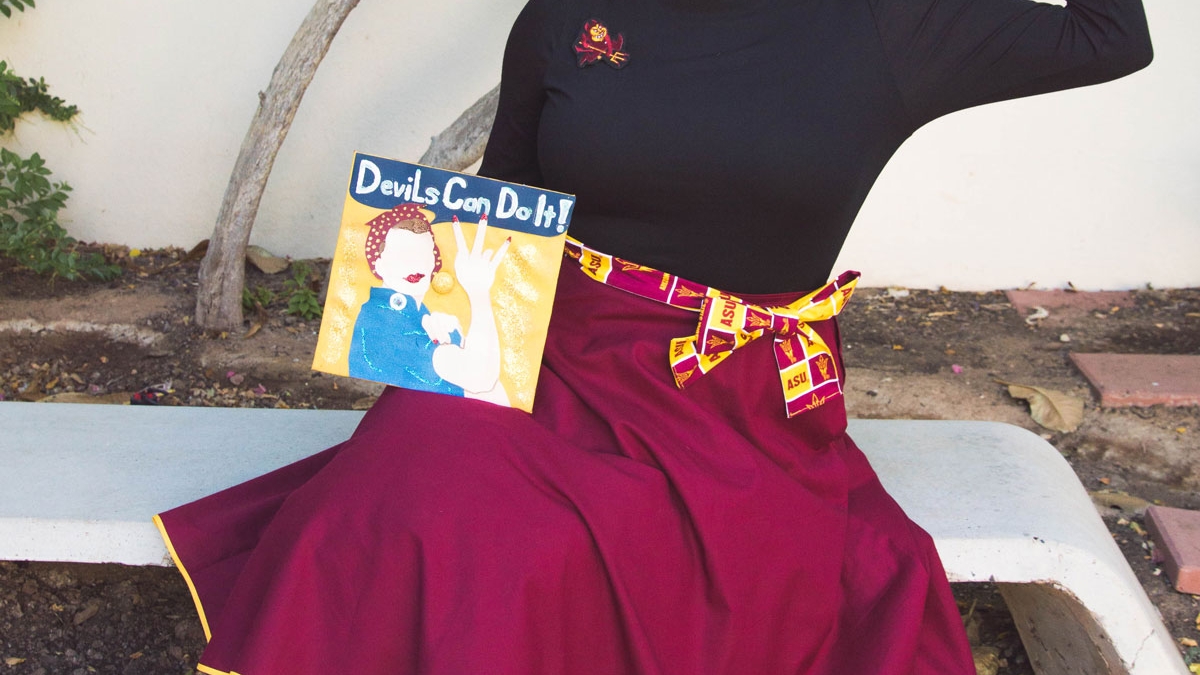Lenora Ott: Dancer, innovator

Lenora Ott with her favorite icon: Rosie the Riveter.
It started with a dance. A belly dancing class — Raqs Sharqui — to be exact, where Lenora Ott first learned about the ASU School for the Future of Innovation in Society’s Global Technology and Development master’s program. After hearing a close friend in the class talk so highly about it, she decided to look into it herself.
But what do global technology, development and dance have in common? Ott, who earned her degree this December, would tell you that they have a lot of similarities and have the potential to work hand-in-hand to make a difference in the way we communicate. She believes that dance can be used as a tool to help assist development, connecting people in ways that go beyond the verbal or written word to come to a deeper understanding of one another through the movement of dance.
Question: What was your "Aha!" moment when you realized you wanted to study the field you majored in?
Answer: My undergraduate degree is in anthropology, so having this global perspective, this desire to understand more about the world was not unusual to me, but having this technology aspect and this idea of development, of improving people’s lives and making the places that they live a better place, that kind of drew me to the program. And also, the fact that my friend really believed that you could take GTD, or Global Technology and Development, and you could make the program fit any area of life that you were especially interested in, and me, as an anthropologist and as a dancer, found that sort of a challenge. And I felt like GTD, proving that dance fit in this development and technology picture was especially important for the arts, which are very dear to me, and also for anthropology.
Q: What’s something that you learned while at ASU, in the classroom or otherwise, that surprised you or that changed your perspective?
A: I think that one of the greatest strengths that programs at ASU have is this ability to take a singular passion in your life, or maybe multiple passions, depending on who you are and what you care about, and find some way to use it to make the world a better place. So, for me, that was dance, but for my friend who told me about the GTD program, it was students who experience study-abroad programs, and for another friend who was also in the program, it was educating refugees and helping them in a new country where they’re learning English and trying to, essentially, rebuild their lives.
Q: Why did you choose ASU?
A: I felt like I really wanted a different change from Texas. I wanted a new perspective, and I wanted to be somewhere where I had the opportunity to really kind of develop the person that I wanted to be, away from everything that I knew and everything that I was comfortable with back home.
For graduate school, the reason I chose ASU is that I’m an employee, and employees do receive a significant tuition benefit, which I really view as a gift because, to me, continuing your education is one of the greatest gifts that anyone can give you. They’re telling me, “If you want to learn things, you can learn them, and we’re here to help you along the way, and your work is accommodating to it.” And they really just empower you to better yourself. So, that’s why I chose ASU. I love this place, and it changed my life.
Q: What’s the best piece of advice you’d give to those still in school?
A: Someone told me, before I started my graduate program, and it’s something that kind of stuck in my mind throughout the whole thing, is that if you know the field that you’re interested in, you should become the kind of student that can turn the most mundane assignment into something that you’re excited about. I always found ways to talk about women’s rights, women’s development, dance if I could squeeze it in there, or arts education if I could squeeze it in there. Also, it’s helpful to constantly keep a record of references of all the material that you’re assigned in class, and any extra assignments that you read you should always keep those, and annotate them and take notes because that’s something that will really help you when you get to writing these massive advanced research thesis, capstone, that sort of thing.
Q: What was your favorite spot on campus, whether for studying, meeting friends, or just thinking about life?
A: Some of my favorite places are sitting in the rocking chairs in the front of the Piper Writer House. You can find me there during lunch, a lot of the lunch hours during the week. I also really love the second floor of Hayden Library that looks out over West Hall, especially around golden hour, around sunset. You get a wonderful view of campus and a wonderful view of the sky from there.
And then, my other favorite spot, currently, is my office. That sounds kind of silly, but our office is really warm and inviting, and we put our personal touches on it. I have my Rosie the Riveter poster in my office I got when I graduated high school. She’s been everywhere that I’ve ever lived in or worked in during my time at ASU. To me, hanging my Rosie poster up on the wall is a big part of making somewhere home for me. Rosie the Riveter, to me, really symbolizes that, someone who is able to just do the hard thing. So, that’s my favorite spot on campus, is sitting with Rosie in my office, and moving forward, moving forward in life.
Q: What are your plans after graduation?
A: I plan on continuing my work with the Center for Evolution in Medicine on the Tempe campus. I’m helping them get their online education programs together, currently. I’m really excited about the mission of the center in using evolutionary biology to help transform medicine, and making medical treatment and medical research infused with evolution is really important for understanding human health, and I really believe that.
I would like to continue to work and do some dance research. I did help Kiki Jenkins with her sea turtle conservation dance she presented at First Fridays at the beginning of November, which, of course, is right in line with my development research, that dance can be used to tell people really interesting stories.
Although my current plans after graduation are not to immediately move into a degree that has to do with my field of study, I definitely feel that my eventual growth could definitely lead in that direction. I could see myself helping plan programs, helping evaluate policy or other ideas that people would like to implement, especially where it concerns arts education. I would really enjoy doing that, and the more experience I get as an employee at ASU, the more skills I take with me when I move into a role that is that way.
Q: If someone gave you $40 million to solve one problem on our planet, what would you tackle?
A: If I had $40 million, I would really work to create educational programs that involve arts, both dance and theater, for children affected in war-torn countries. I think that the arts really can be a good and positive outlet for children that have experienced trauma, and inspiring that creativity back in children at that very critical stage in their life is really important for creating successful, holistic adults. I feel that the arts is kind of the thread that is our humanity, and so art and dance education could really help heal.
Written by Madelyn Nelson
More Health and medicine

ASU's Roybal Center aims to give older adults experiencing cognitive decline more independence
For older people living alone and suffering from cognitive decline, life can be an unsettling and sometimes scary experience.…

Dynamic data duo advances health research
The latest health research promises futuristic treatments, from cancer vaccines to bioengineered organs for transplants…

New study reveals high levels of toxins in seized cannabis from Arizona and California
A recent study conducted by researchers from Arizona State University has uncovered alarming levels of Fusarium mycotoxins in…

